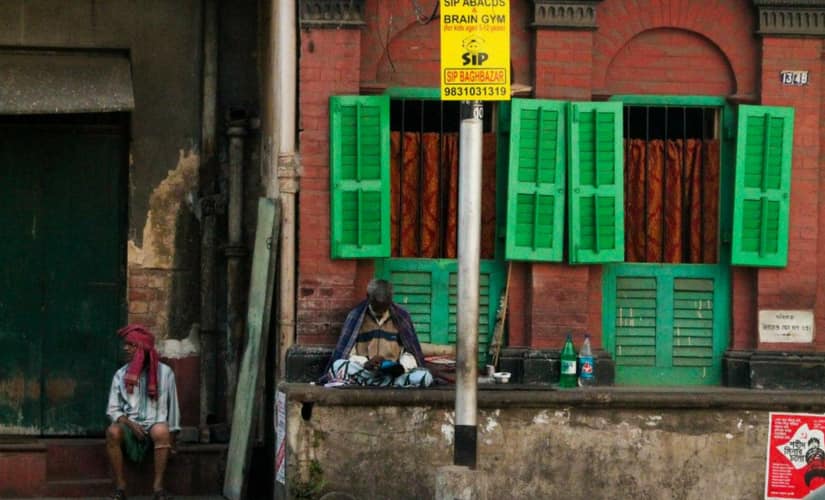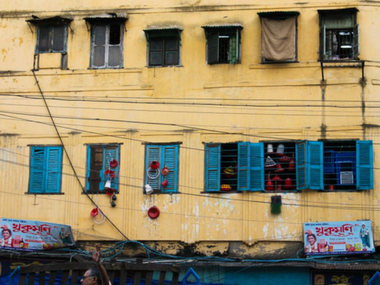The City of Joy is — more often than not — defined by its old houses that stand as a bridge between its past glory and present oblivion. Indian-European structures with open terraces, spacious porches, red-oxide floors, wrought iron grilles and green windows make these homes hard to miss as you walk down the bylanes and alleys of north and central Kolkata. The architectural ethos of the city comes alive through the intricate and detailed cornices of the big buildings that have witnessed historical transitions of the last one or more centuries. While the people of the city and tourists often value these houses for their rich heritage, the buildings have seen their own battles with numerous tenants and risks of demolition. Over time, many of these zamindari buildings, which are majestic in their size, have been divided by family disputes and property issues with the municipality. [caption id=“attachment_4320165” align=“alignnone” width=“825”] Basubati, an old house in the Baghbazar area of north Kolkata undergoes construction. All photos taken by the author[/caption] Thirty-three-year-old Somnath Basu who resides on Balaram Ghosh Street in Shyambazar area of north Kolkata speaks fondly of his ancestral house (originally located opposite their present residence that was built in 1960s). Over the years, the ancestral house was separated to accommodate different members of the family. As families expanded, more room had to be made for many of the children and their families. One part of the house now accommodates Model KG School, two sections belong to Basu’s grand-uncle and grand-aunt respectively and one part belongs to a cinematographer. There is another part which is owned by a distant cousin. Basu goes on to explain why many of the houses around these areas are being sold off despite being heritage property. “Most of the people across north Kolkata are selling off their houses because they cannot maintain them. With servants and workmen becoming expensive to hire, maintenance is becoming un-affordable and impossible,” Basu said. He, however, hopes to live in the house and restore parts of his own old house. The Central Avenue near the prominent Tropical School of Medicine has several big, old houses along the main road and bylanes. Ranabir Mullick, a resident of one such house built in early 1900s on Debendra Mullick Street, speaks of how one home has expanded over the years to accommodate more members of the family. The interiors of the house have undergone modifications with modern day lifestyle changes but maintenance, he says, is expensive as repairs are required every other day. A few members have shifted out due to space crunch but no original member has yet given up on their part of the house. The ground floor now has many medical shops as tenants. Twenty-year-old Prajukti Sen of Jagannath Sur Lane near Beadon Street of Hatibagan is very glad to have grown up in a 300-year-old house. The house was divided in the 1800s among her great great grandfather’s siblings but soon many members of the family left the building after selling their respective parts because lack of space was an issue, as were the heavy maintenance costs. However, Sen who belongs to the present generation is not okay with the idea of leaving the house. “If it is me, or my cousins or even our parents, we would not be very comfortable in leaving this place, this house or the locality. I’ve seen this being renovated when necessary and it’s still very strong. I remember I felt very happy — still do — when we had lots of relatives coming in for a gathering or when Durga Pujo started. My generation spent all those afternoons on the terrace with our grandparents, just like out of a Rabindranath Tagore’s tale. Now, it might seem odd and sad also thinking of moving out. Maybe flats are better now for nuclear families as they grant more privacy but my cousins or I would not be comfortable with the idea.” Not every one has been fortunate to still hold on to their heritage. Ninety-year-old Gouranga Nath Basu Mallik reminisces about his four-storeyed old house on Central Avenue in central Kolkata. The nonagenarian recalls how he had escaped his house in Bowbazar during the riots in 1947 and returned after the situation improved in the city. Mallik and his siblings found it hard to maintain the house and moved out in 1992 after selling it to a Marwari family. While Mallik lives in his own house in Salt Lake now, the Bowbazar house is used as nursing home in the area now. [caption id=“attachment_4320171” align=“alignnone” width=“825”]
 As highrises replace many of these monuments of the bygone era, one wonders how long Kolkata will retain this aspect of its identity[/caption] There are a few dilapidated houses in Tiretta Bazaar which are also homes to Chinese immigrants who have been a part of the city for decades. Chuenchen Liu’s father had moved into their house 50 years ago when he had obtained citizenship. The rent has been low since then but renovation has been a challenge for the families dwelling in the buildings. “There is only one entrance to the building which is not always maintained. Once in a while someone cleans it. In case of any emergency, we really do not know how to escape the building. Since all the families have been living here for a long time and the location is good, none of us want to move out now,” says 23-year-old Liu. As highrises replace many of these monuments of the bygone era, one wonders how long will Kolkata retain this face of its identity. An official from Kolkata Municipal Corporation (KMC) Saikat Saha says only prominent buildings under their jurisdiction are eligible for redevelopment. The rest are private properties, the onus for whose development lies with the owners or tenants, as the case may be. However, before any renovation is carried out, permission is required from KMC and in case a building is dilapidated enough to be on the verge of collapse, KMC issues a notice asking the inmates to vacate the building. However, tough measures are rarely taken. In 2016, author
Amit Chaudhuri had spoken about his campaign to save the old houses of Kolkata . His movement had primarily focused on the south Kolkata houses built by middle-class Bengalis and Chaudhuri had said that he fears that in 10 years nothing of this will remain unless some step is actively taken. However, the saving grace for many of the old mansions are their young owners, scions of prominent families who refuse to let go of their heritage or memories. Before it’s too late, perhaps many more campaigns will ensure the renovation and revival of neo-Gothic buildings that boast of Victorian influences. As someone who grew up in the city, I do hope to see it defy time and change. Old men brooding over newspapers, debating politics and the economy sitting across open porches and terraces, women bonding through wrought-iron grilles as families gather for pujas in expansive courtyards… for many, it would be a chance to live ‘yesterday, once more’.
As highrises replace many of these monuments of the bygone era, one wonders how long Kolkata will retain this aspect of its identity[/caption] There are a few dilapidated houses in Tiretta Bazaar which are also homes to Chinese immigrants who have been a part of the city for decades. Chuenchen Liu’s father had moved into their house 50 years ago when he had obtained citizenship. The rent has been low since then but renovation has been a challenge for the families dwelling in the buildings. “There is only one entrance to the building which is not always maintained. Once in a while someone cleans it. In case of any emergency, we really do not know how to escape the building. Since all the families have been living here for a long time and the location is good, none of us want to move out now,” says 23-year-old Liu. As highrises replace many of these monuments of the bygone era, one wonders how long will Kolkata retain this face of its identity. An official from Kolkata Municipal Corporation (KMC) Saikat Saha says only prominent buildings under their jurisdiction are eligible for redevelopment. The rest are private properties, the onus for whose development lies with the owners or tenants, as the case may be. However, before any renovation is carried out, permission is required from KMC and in case a building is dilapidated enough to be on the verge of collapse, KMC issues a notice asking the inmates to vacate the building. However, tough measures are rarely taken. In 2016, author
Amit Chaudhuri had spoken about his campaign to save the old houses of Kolkata . His movement had primarily focused on the south Kolkata houses built by middle-class Bengalis and Chaudhuri had said that he fears that in 10 years nothing of this will remain unless some step is actively taken. However, the saving grace for many of the old mansions are their young owners, scions of prominent families who refuse to let go of their heritage or memories. Before it’s too late, perhaps many more campaigns will ensure the renovation and revival of neo-Gothic buildings that boast of Victorian influences. As someone who grew up in the city, I do hope to see it defy time and change. Old men brooding over newspapers, debating politics and the economy sitting across open porches and terraces, women bonding through wrought-iron grilles as families gather for pujas in expansive courtyards… for many, it would be a chance to live ‘yesterday, once more’.
Unless Kolkata’s old houses are saved, the city will lose a large part of its heritage and identity | #FirstCulture
Advertisement
End of Article


)
)
)
)
)
)
)
)
)



